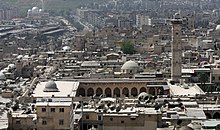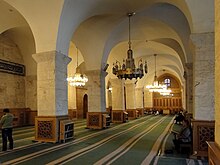Great Mosque of Aleppo
| Great Mosque of Aleppo | |
|---|---|
جَـامِـع حَـلَـب الْـكَـبِـيْـر | |
 Panoramic view in 2010 | |
| Religion | |
| Affiliation | Islam |
| Status | Temporarily closed |
| Location | |
| Location | Al-Jalloum district, Aleppo, Syria |
| Geographic coordinates | 36°11′58″N 37°09′25″E / 36.199492°N 37.156911°E |
| Architecture | |
| Architect(s) | Hasan ibn Mufarraj al-Sarmini |
| Type | Mosque |
| Style | Pre-Islamic,[a] North Syrian, Umayyad, Seljuk, Mamluk |
| Completed | 715, 13th century |
| Specifications | |
| Dome(s) | 1 |
| Minaret(s) | 1 (destroyed during the Syrian civil war) |
| Materials | stone |
The Great Mosque of Aleppo (
History
Founding
The site of the Great Mosque was once the
The mosque was built on land that formerly was used as the Cathedral cemetery.
However, architectural historian
Renovation
In the second half of the 11th century, the
The
The courtyard and minaret of the mosque were renovated in 2003.[12]
Syrian Civil War

On 13 October 2012 the mosque was seriously damaged during clashes between the armed groups of the Free Syrian Army and the Syrian Army forces. President Bashar al-Assad issued a presidential decree to form a committee to repair the mosque by the end of 2013.[20]
The mosque was seized by rebel forces in early 2013, and, as of April 2013, was within an area of heavy fighting, with government forces stationed 200 meters (660 ft) away.[21]
On the 24th of April, 2013, the minaret of the mosque was reduced to rubble during an exchange of heavy weapons fire between government forces and rebels during the ongoing
Architecture

Courtyard
The Great Mosque contains a number of architectural similarities to the Great Mosque of Damascus, including a hypostyle plan with large marbled courtyard surrounded by porticoes. The vast courtyard connects to different areas of the mosque, positioned behind the colonnaded arcade. The courtyard is well known for its alternating black and white stone floor that forms intricate geometric arrangements. Two ablutions fountains,[12] both of which are roofed. The courtyard also has an open prayer estrade and a sundial.[19]
Interior

The
There are three other halls that abut the remaining sides of the courtyard. The eastern and northern halls each have two naves, while the western hall has one. The latter is mostly of modern construction. The east hall dates to the period of Malik Shah (1072–92) and the north hall was renovated during Mamluk sultan Barquq's reign (1382–1399), but largely maintained its original 11th century character.[19]
Minaret
The
According to E.J. Brill's First Encyclopaedia of Islam, the minaret was "quite unique in the whole of Muslim architecture".
Maqsurah
The Great Mosque has a small museum annexed to it containing a number of ancient manuscripts. Similar to the Great Mosque of Damascus, a maqsurah was built in the form of a square domed room raised by one step above the floor level of the prayer hall, and adorned with Kashan tiles that cover all the internal surfaces of its walls. A large arched gate supported by two robust columns and topped with capitals as well as a bronze door screen comprise the entranceways to the maqsurah. The tomb containing the remains of Prophet Zakariah, decorated with silver embroideries containing Quranic verses from the chapter of Mariyam, was located in the center of the room.[27] The museum's number of valuable objects, including a box purportedly containing a strand of the Prophet Muhammad's hair, were subject to looting during the Syrian War in the 2013 clash. However, rebels claimed they had instead salvaged ancient handwritten Koranic manuscripts and hidden them.[28]
Gallery
-
The gate
-
The gate
-
Islamic ornaments on facade
-
Visitors in courtyard
-
The shrine ofZechariahwithin the Mosque
-
The minaret, before destruction in April 2013
-
Ablution fountains
-
Mihrab and minbar of the Mosque
-
View from the citadel, before destruction of the minaret in April 2013
-
Upper minaret, before 2013 destruction
-
Great Mosque of Aleppo (December 2016)
-
Inside view of the Great Mosque of Aleppo
-
Full view of the mosque
-
Courtyard arcade
-
Location within Aleppo
See also
- Citadel of Aleppo
- List of heritage sites damaged during the Syrian civil war
- Religious significance of the Syrian region
- Umayyad Mosque
Notes
- ^ Hillenbrand (1994),[1] Raby (2004),[2] and the Museum with No Frontiers;[3] taking the 7th century CE as the time of the start of Islamic architecture.[4]
References
- ^ Robert, Hillenbrand (1994), Necipoglu, Gulru (ed.), Islamic Architecture: Form, Function, and Meaning, Columbia University Press, p. 140,
At the top is the main cornice of the tower. It is made of flat niches – as opposed to concave muqarnas cells – and entirely decorated with tiny arabesques. The style of this minaret's decoration reveals the continuity of Syrian pre-Islamic and Roman architectural heritage.
- ISBN 9004139648,
… they perpetuate the outer shell of pre-Islamic Syrian towers, of which the minarets of the mosques of Aleppo and Ma'arrat al-Nu'man preserve ...
- ^ "Discover Islamic Art". Museum with No Frontiers. 2004–2018. Retrieved 2018-03-14.
- ISBN 978-1442263093.
- ^ "The Great Mosque of Aleppo | Muslim Heritage". www.muslimheritage.com. 24 March 2005. Retrieved 2016-06-30.
- ^ a b c The Great Mosque (The Umayyad Mosque) Archived 2008-11-03 at the Wayback Machine Syria Gate.
- ^ Gospel of Luke, Luke 1:5–79
- ^ a b ed. Mitchell, 1978, p. 231.
- ^ a b "Syria clashes destroy ancient Aleppo minaret". bbc.co.uk. 24 April 2013. Retrieved 24 April 2013.
- ^ a b c Bacharach, ed. Necipoglu, 1996, p. 34.
- ISBN 978-1-119-06857-0. Retrieved 13 August 2022.
- ^ a b c d e f g Great Mosque of Aleppo Archived 2009-07-15 at the Wayback Machine Archnet Digital Library.
- ^ Tabaa, 1997, p. 17.
- ^ Tabaa, 1997, p. 40.
- ^ a b c Brend, 1991, p. 99.
- ^ a b Allen, Terry. (2003). "Chapter Two. The Ornamented Style in Aleppo and Damascus." In Ayyubid Architecture. Occidental. Solipsist Press.
- ^ Grousset, 1991, p. 362.
- ^ Vandekerckhove 2019, p. 48-49.
- ^ a b c d e f g h i ed. Houtsma, 1987, p. 236.
- ^ Karam, Zeina. "Historic Aleppo mosque damaged in fighting; repairs ordered". The Washington Times. Retrieved 26 April 2013.
- ^ a b Minaret of historic Syrian mosque destroyed in Aleppo. Associated Press. 24 April 2013. Retrieved 25 April 2013.
{{cite book}}:|work=ignored (help) - ^ Saad, Hwaida; Gladstone, Rick (24 April 2013). "Storied Syrian Mosque's Minaret Is Destroyed". The New York Times. Retrieved 24 April 2013.
- ^ a b Spencer, Richard (24 April 2013). "Syria: 11th-century minaret of Great Umayyad Mosque of Aleppo destroyed". The Daily Telegraph. Retrieved 25 April 2013.
- ^ Fisk, Robert. "Syrians aren't just rebuilding an ancient mosque in Aleppo – they are rebuilding their community".
- ^ Houtsma, 1987, p. 235.
- ^ Raby, ed. Necipoglu, p. 290.
- ^ "The Great Mosque of Aleppo | Muslim Heritage". www.muslimheritage.com. 24 March 2005. Retrieved 2016-06-30.
- ^ "Syria clashes destroy ancient Aleppo minaret - BBC News". BBC News. 24 April 2013. Retrieved 2016-06-30.
Bibliography
- ISBN 9004106332.
- Brend, Barbara (1991). Islamic Art. Harvard University Press. ISBN 067446866X.
great mosque aleppo minaret.
- Grousset, Rene (1991). The Empire of the Steppes: A History of Central Asia. Rutgers University Press.
- Martijin Theodoor Houtsma, ed. (1987). E.J. Brill's First Encyclopaedia of Islam 1913–1936. Vol. 3. BRILL. ISBN 9004082654.
- George Mitchell, ed. (1978). Architecture of the Islamic World. Thames and Hudson.
- Tabaa, Yasser (1997). Constructions of power and piety in medieval Aleppo. Penn State Press. ISBN 0-271-01562-4.
- Vandekerckhove, Dweezil (2019). Medieval Fortifications in Cilicia: The Armenian Contribution to Military Architecture in the Middle Ages. BRILL. ISBN 9789004417410.
External links
- Photo of damage taken from the Facebook page of Le patrimoine archéologique syrien en danger
- Photo of damage Archived 2013-02-01 at the Le patrimoine archéologique syrien en danger
- Photo of damage Archived 2013-02-01 at the Le patrimoine archéologique syrien en danger
- Photo of damage Archived 2013-02-01 at the Le patrimoine archéologique syrien en danger
- Photo of damage taken from the Facebook page of Le patrimoine archéologique syrien en danger
- Great Mosque of Aleppo on YouTube




















